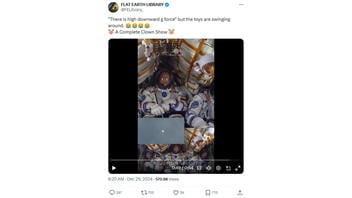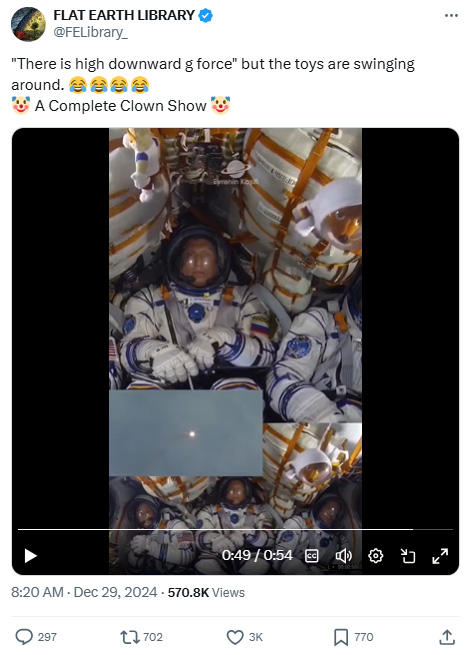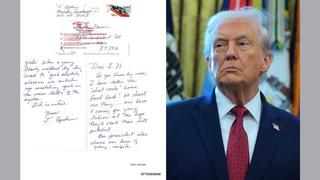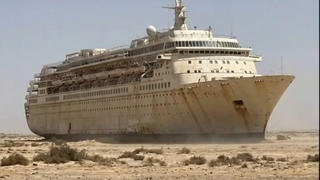
Does the swinging action of stuffed toys hanging from the ceiling of the Soyuz crew capsule prove that the spacecraft is not really producing the expected G forces during a launch into orbit, suggesting fakery? No, that's not true: A spacecraft will experience varying G forces and vibrations during launch. A social media post's short video clip was taken from the first minute after liftoff, which does not show the time when the spacecraft experienced the peak load of 4 G.
The claim appeared in a post (archived here) published on X on December 29, 2024. The post was captioned:
"There is high downward g force" but the toys are swinging around. 😂😂😂😂
🤡 A Complete Clown Show 🤡
This is how the post appeared on X at the time of writing:
(Source: X screenshot taken on Tue Dec 31 15:16:42 2024 UTC)
The clip in the X post is 54 seconds long and shows the crew of three in the first minute after liftoff on their way to the International Space Station (ISS). The full ten minutes of footage (embedded below and archived here) of the "Horizons mission - Soyuz: launch to orbit" was posted on YouTube by the European Space Agency (ESA) on June 25, 2018. The footage in question appears between the 0:27 second and 1:20 minute mark. Not included in the short clip is the moment (at 8:45 minutes in) when the engines are cut, the third stage is cut off, and the solar panels of the Soyuz MS-09 are deployed. At this time, the capsule reached orbit. In the footage, the strings suspending the stuffed toys above the astronauts become lax as the toys begin to float.
These toy mascots are called "zero-G indicators" (archived here) and the tradition dates back to the first manned space flight in 1961 when Soviet cosmonaut Yuri A. Gagarin purportedly took a little doll with him on Vostok 1 to see it float when he reached zero gravity. G force (archived here) is a unit of measuring the magnitude of force, with 1 G being equal to the Earth's gravity. The caption of the ESA video contains a description of the G forces and the double duty role of the mascots:
During a Soyuz launch astronauts typically experience forces of up to 4g - having to work while being pressed into their seats with a force that is four times more than the gravity felt on Earth. The Soyuz commander uses a stick to press buttons as they are too far away from the control panel.
The fluffy toys above the astronauts' heads are mascots and good luck charms but also serve as a simple but effective test to see when the spacecraft is in orbit: when they start to float the spacecraft is weightless and orbiting Earth. Above Sergei is the mascot for the 2018 FIFA soccer World Cup held in Russia. Alexander took German children television icon "Die Maus" with him.
Although not mentioned in the caption, astronauts also experience vibrations during a rocket launch. One NASA astronaut, Jeff Williams (archived here), journaled about his experience on Expedition 13 to the ISS which was launched with the same Soyuz-FG rocket as was used for the Horizons Mission (the NASA webpage of Williams' journal remains archived here). Williams was one of a crew of three carried to the International Space Station on the Soyuz TMA-8 spacecraft launched on March 30, 2006. He wrote:
The dynamics of liftoff actually began several seconds before as the engines went through the start-up sequence, with obvious associated vibrations. Liftoff is an obvious kick accompanied by a moderate shake. The 'g' level is relatively low at first and gradually builds up to about 4 g's at the 2-minute point. At that point a couple of significant events occurred which can be rather surprising if you're not prepared for them. The first was the jettisoning of the launch abort system mounted on the nose of the rocket, which occurred with a moderate bang. A few seconds later, the first staging occurred which resulted in an immediate drop in g-load from 4 to about 1 g. The shaking and vibration continued at a reduced magnitude as we then continued on the second stage. At a little over 2 ½ minutes into the flight, the shroud around the spacecraft was jettisoned with a large 'explosion' of pyrotechnics and sudden brightness in the cockpit from sunlight through the newly exposed windows. Then a little over 2 minutes later at just shy of 5 minutes into the flight, the next staging occurred when we went from about 2 ½ g's, momentarily to zero and then back to about 1 g with the starting of the 3rd stage engine. Going back to 1 g provided the opportunity to cover the window with a shade so that the displays were readable. The ascent continued for a total of just under 9 minutes when the engines shut down and we were weightless.
Some of the events described in William's 2006 account are visible in the 2018 video. At the 3:00 minute mark the shroud is jettisoned and light comes flooding in the capsule windows, then the narrator says, "Now we're reaching peak G load during the launch phase." So the footage in the short video clip on X does not show a peak load of 4 G, but something well below that and gradually increasing. Indeed, a difference in the swinging action of the toys can be observed by comparing how they move freely at 0:30 seconds to 3:30 minutes when they move as though tethered, under peak G load.
At 9:00 minutes in the engine is cut off and there is a noticeable jolt to the crew and mascots at which point the exterior camera shows the third stage (diagram of the Soyuz FG rocket here) falling away from the Soyuz MS-09 as it orbits over Earth. The next view to the capsule interior shows the mascots floating -- indicating they have reached zero gravity and are now in orbit.
Lead Stories reached out to NASA for comment and on January 6, 2025 we received a reply by email from NASA Space Operations Public Affairs Officer Jimi Russell. He wrote:
During launch and the initial ascent phase, a rocket is subjected to four forces: weight, thrust, lift and drag. In flight, the magnitude and the direction of the forces acting on the rocket is constantly changing. Some larger rockets, like those used to launch humans and heavy payloads, also can move, or gimbal, their exhaust nozzles to maneuver which also produces a torquing-like force not aligned with the rocket's center of gravity. Additionally, a rocket must also contend with environmental conditions aloft (e.g., winds, turbulence, etc.) that can impact the "ride" during ascent.
NASA's Stemonstrations video series discusses Newton's Laws of Motion, which is helpful in explaining how these forces act upon spacecraft and other objects in space: https://plus.nasa.gov/series/stemonstrations/
Additional Lead Stories fact checks on claims regarding flat earth and space program conspiracies can be found here and here.
















